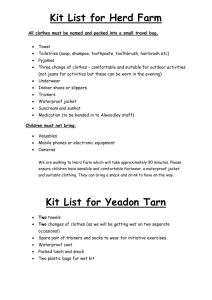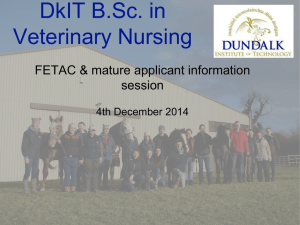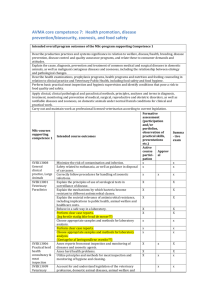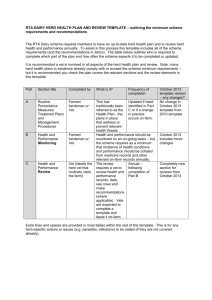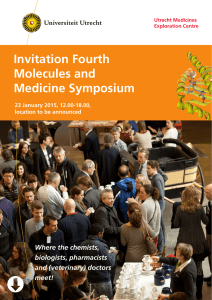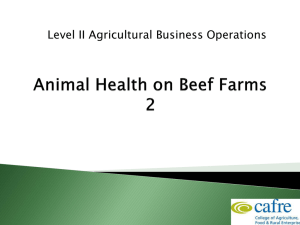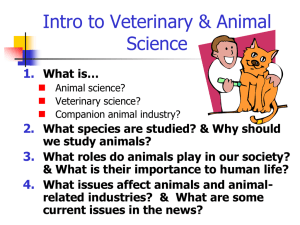Dairy Animal Health Week 2
advertisement
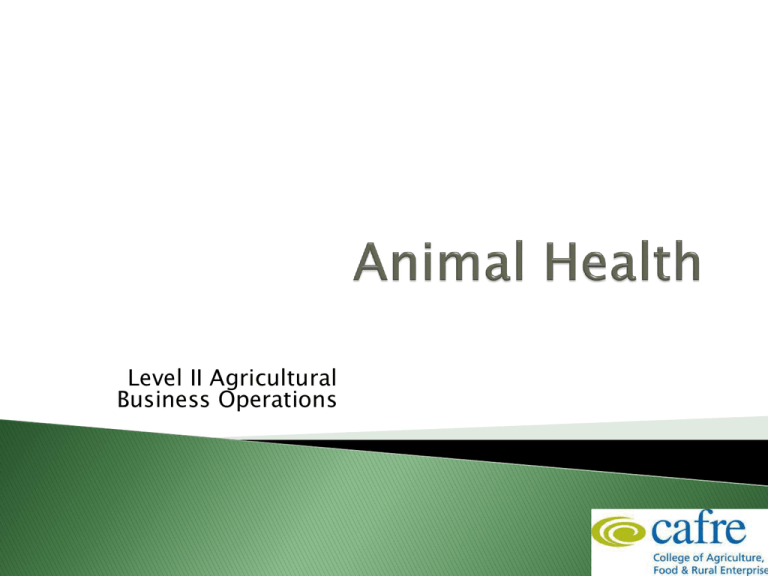
Level II Agricultural Business Operations This session will include ◦ Biosecurity ◦ Herd health planning ◦ Safe use of veterinary medicines Maintenance of herd health is important because ◦ Additional costs for treatments and losses ◦ Reduced production efficiency ◦ Reduced quality of marketable product ◦ Consumer perception of animal welfare Biosecurity is the prevention of disease causing agents entering or leaving any place where they can pose a risk to farm animals, other animals, humans, or the safety and quality of a food product. The same principles apply within the farm, preventing disease spreading between animals and groups Weather Water People Stock Animals Vehicles Feed Visitors, without disinfection Colostrum from one farm to another Hoof trimmers dirty equipment Vets with dirty equipment Dead lorry - carcass disposal Slurry contractors Safeguards herd against disease reducing stress on animals and farmer Safeguards human health Improves production efficiency by reducing the spread of disease within farm Stops the spread of disease to other farms Protects export markets Maintain a closed herd Pre-test and isolate purchased or sick animals Restrict visitor access Provide boot washing/disinfection facilities Use common sense when moving around farm Restrict access to water courses/neighbouring stock The factors above should be included in a Herd Health Plan Measure - Identify disease Manage - Prioritise improvements Monitor - Assess progress Advice - Seek professional advice Produced in conjunction with vet Documents routine procedures, treatments and vaccinations Sets and monitors targets against mortality and disease incidence Quality assurance scheme requirement Should include ◦ Routine preventative measures ◦ Treatment plans ◦ Management procedures ◦ Health performance monitoring ◦ Health performance review ◦ Action plan calendar Points for consideration Routine husbandry treatments Vaccinations Parasite control Month Oct Routine Treatments Colostrum Navel disinfect Tissue tag Disbudding 2nd Pneumonia Jan Feb Mar Apr Turn out Parasites Cryptosporidia 1st Pneumonia Nov Dec Vaccinations 1st Leptospirosis 1st Clostridial 2nd Leptospirosis 2nd Clostridial Coccidiosis Month Routine Treatments May June Vaccinations Parasites 2nd Leptospirosis 2nd Clostridial Pulse bolus worms 1st BVD Liver fluke Fly treatment July Aug Fly treatment 2nd BVD Sept Oct Freeze brand Nov Service prep Pneumonia booster Routes of Administration: Injection ◦ Subcutaneous ◦ Intramuscular ◦ Intravenous (vet) ◦ Intranasal Intramammary: Dry-cow tubes Topical: Pour-on, Spraying, Dipping Oral: Dosing, Bolus, In feed Health and Safety ◦ Protective equipment ◦ Animal Restraining Equipment Know weight of animal (to know dose rate) Read instructions on label ◦ Every medicine is different! Correct medicine storage ◦ Secure store/cabinet (or fridge where necessary) ◦ Adhere to storage instructions Clean equipment: Syringes/Needle(s) 1. Ensure coat is clean and dry 2. Fold loose skin behind shoulder, hold syringe with other hand 3. When animal is calm insert the needle at 45°, squeeze the barrel slowly 4. There should be no resistance 5. Let the skin go flat, hold the insertion point with your thumb and then gently remove the needle 6. Rub the injection site gently to disperse all the medicine 1. Hold the needle in one hand 2. Prepare the skin around the injection site by tapping it with the outside of your fist, on the 3rd tap, pierce the skin with the needle 3. Place the syringe on the needle and slowly inject the solution 4. To extract the needle hold the skin around it with your other hand and gently withdraw the needle 5. Rub the injection site gently to disperse all the medicine. Antibiotics are essential for the treatment of infectious diseases in both animals and humans Antibiotic resistance is the ability of bacteria that are usually sensitive to a type of antibiotic to become resistant to it The more you use an antibiotic, the higher the risk that bacteria will develop resistance to it Why worry about it? ◦ Very few new antibiotics being developed ◦ Important we use our existing antibiotics wisely to ensure these life-saving medicines continue to stay effective for ourselves and our animals Important we use antibiotics in the right way: ◦ the right medicine ◦ at the right dose ◦ at the right time ◦ the right duration to slow down the development of antibiotic resistance http://www.dardni.gov.uk/responsible-use-of-antimicrobials-in-livestockleaflet.15.108_responsible_use_of_antimicrobials_in_livestock_leaflet_final_2.pdf Legislative requirement to record; ◦ Purchase of veterinary medicines ◦ Administration of veterinary medicines ◦ Disposal of unused veterinary medicines ◦ Disease occurrences on farm ◦ Keep records for five years Food Standards Agency Farm Quality Assurance Scheme Milk processors Supermarkets DARD Veterinary Service DARD Agri-Food Inspection Branch Locked medicine cabinet Sharps container Record book in cabinet Vet has suggested treating with Hexasol LA Initial intramuscular injection at 1ml/10kg lwt Sick calf, 40kg, showing signs of pneumonia Isolate calf, dry straw bed 2/10/14 Hexasol La 100ml 3321- 5/8/15 91 Andy Vet, 14 Practice Road, Mallusk. BT36 4TY 35 days Hexasol LA 123456 AF 234-5 35 4 ml 332191 Andy Vet - Schemes designed to monitor, control and ultimately eradicate a specific disease within a herd: BVD Johne’s Disease IBR Leptospirosis Herds may achieve ‘accredited disease free’ status for specific disease http://www.animalhealthni.com/ Biosecurity is vital for animal health and well being Herd health planning is essential Veterinary medicine records required

